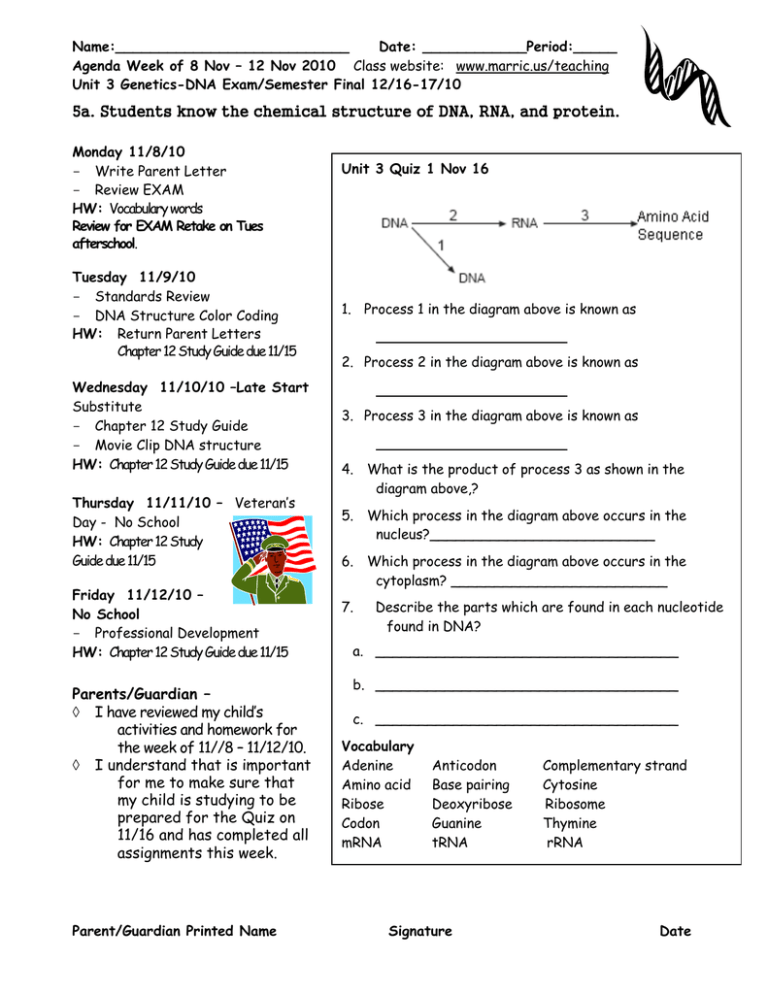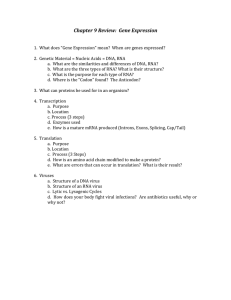Name:___________________________ Date: ____________Period:_____
advertisement

Name:___________________________ Date: ____________Period:_____ Agenda Week of 8 Nov – 12 Nov 2010 Class website: www.marric.us/teaching Unit 3 Genetics-DNA Exam/Semester Final 12/16-17/10 5a. Students know the chemical structure of DNA, RNA, and protein. Monday 11/8/10 - Write Parent Letter - Review EXAM HW: Vocabulary words Review for EXAM Retake on Tues afterschool. Tuesday 11/9/10 - Standards Review - DNA Structure Color Coding HW: Return Parent Letters Chapter 12 Study Guide due 11/15 Wednesday 11/10/10 –Late Start Substitute - Chapter 12 Study Guide - Movie Clip DNA structure HW: Chapter 12 Study Guide due 11/15 Thursday 11/11/10 – Veteran’s Day - No School HW: Chapter 12 Study Guide due 11/15 Friday 11/12/10 – No School - Professional Development HW: Chapter 12 Study Guide due 11/15 Parents/Guardian – I have reviewed my child’s activities and homework for the week of 11//8 – 11/12/10. I understand that is important for me to make sure that my child is studying to be prepared for the Quiz on 11/16 and has completed all assignments this week. Parent/Guardian Printed Name Unit 3 Quiz 1 Nov 16 1. Process 1 in the diagram above is known as 2. Process 2 in the diagram above is known as 3. Process 3 in the diagram above is known as 4. What is the product of process 3 as shown in the diagram above,? 5. Which process in the diagram above occurs in the nucleus?__________________________ 6. Which process in the diagram above occurs in the cytoplasm? _________________________ 7. Describe the parts which are found in each nucleotide found in DNA? a. ___________________________________ b. ___________________________________ c. ___________________________________ Vocabulary Adenine Amino acid Ribose Codon mRNA Anticodon Base pairing Deoxyribose Guanine tRNA Signature Complementary strand Cytosine Ribosome Thymine rRNA Date Bell Ringers: Week of 8 Nov – 12 Nov 2010 Monday - Match A general equation for a chemical reaction is shown: Which substance is represented by letter A? a) amylase b) protease polypeptide + water c) lipase A amino acids d) maltase Tuesday The graph indicates that pepsin would function best in the_________________ a) mouth b) small intestine c) stomach d) large intestine Pepsin and trypsin are classified as ___________ made of ______________________ Wednesday – Nucleic acids include RNA and DNA what does RNA and DNA stand for. What are the monomers of nucleic acid. DNA= RNA= Nucleic Acid monomers = Thursday – Veteran’s Day Friday – Professional Development Name:_______________________________ Date:____________________ Period:______ Unit 3 Quiz 1 Nov 16 1. Process 1 in the diagram above is known as _____________ 2. Process 2 in the diagram above is known as 3. Process 3 in the diagram above is known as _______ _______ 4. Which process in the diagram above occurs in the cytoplasm? _________________________ 5. What is the product of process 3 as shown in the diagram above,? _____________________ 6. Which process in the diagram above occurs in the nucleus?____________________________ 7. Describe the parts which are found in each nucleotide found in DNA? a. ___________________________________ b. ___________________________________ c. ___________________________________ Which of these would be the best conclusion regarding the experimental results shown? A The tallest this species of plant will ever grow is 50 cm. B This species of plant grew best between 18°C and 24°C. C The ideal temperature for all plant growth is 26°C. D Plants will not grow above 26°C. Adenine Anticodon Amino acid Ribosome Complementary strand Base pairing Ribose mRNA Cytosine Deoxyribose Codon tRNA Thymine Nucleotide Guanine rRNA ___________________ A. monomer of nucleic acid ___________________ B. three bases on messenger RNA that code for an amino acid, complementary to an anticodon ___________________ C. the sugar in a nucleotide of DNA ___________________ D. a nitrogen base that is a pyrimidine, base pairs with adenine and found only in DNA. ___________________ E. The type of RNA that brings amino acids to the site of protein synthesis. ___________________ F. a nitrogen base that is a purine and base-pairs with thymine in DNA and uracil in RNA ___________________ G. Hydrogen bonds between nitrogen bases of nucleotides, it is the basis for the double helix shape of DNA ___________________ H. monomer of proteins ___________________ I. the sugar in a nucleotide of RNA ___________________ J. ___________________ K. a sequence of three nucleotides on a transfer RNA that base pairs with three nucleotides on messenger RNA ___________________ L. a base-paired chain of nucleic acid ___________________ M. a nitrogen base that is a purine and binds with cytosine in either RNA or DNA ___________________ N. Made of ribosomal RNA and protein, is the site of protein synthesis, where messenger RNA and transfer RNA base-pair. ___________________ O. The type of RNA that transmits genetic information from the nucleus to the cytoplasm. ___________________ P. The type of RNA that makes up ribosomes a nitrogen base that is a pyrimidine, base pairs with guanine and found in both RNA and DNA. Scientists can use genetic information to identify people because it is unique to each person. Which specific characteristic is unique to an individual? A The shape of the DNA molecules in cells C The sequence of DNA nucleotides in cells B The number of chromosomes in each cell D The size of each chromosome in a cell Name:_______________________________ Date:____________________ Period:______ Unit 3 Quiz 1 1. Describe the parts which are found in each nucleotide found in DNA? a. ___________________________________ b. ___________________________________ c. ___________________________________ 2. Process 1 in the diagram above is known as _____________ 3. Process 2 in the diagram above is known as 4. Process 3 in the diagram above is known as _______ _______ 5. Which process in the diagram above occurs in the cytoplasm? _________________________ 6. What is the product of process 3 as shown in the diagram above,? _____________________ 7. Which process in the diagram above occurs in the nucleus?____________________________ Which of these would be the best conclusion regarding the experimental results shown? A Plants will not grow above 26°C. B The tallest this species of plant will ever grow is 50 cm. C The ideal temperature for all plant growth is 26°C. D This species of plant grew best between 18°C and 24°C. Matching Adenine Anticodon Amino acid Ribosome Complementary strand Base pairing Ribose mRNA Cytosine Deoxyribose Codon tRNA Thymine Nucleotide Guanine rRNA ___________________ A. the sugar in a nucleotide of DNA ___________________ B. three bases on messenger RNA that code for an amino acid, complementary to an anticodon ___________________ C. monomer of nucleic acid ___________________ D. The type of RNA that makes up ribosomes. ___________________ E. a nitrogen base that is a pyrimidine, base pairs with adenine and found only in DNA. ___________________ F. a sequence of three nucleotides on a transfer RNA that base pairs with three nucleotides on messenger RNA ___________________ G. Hydrogen bonds between nitrogen bases of nucleotides, it is the basis for the double helix shape of DNA ___________________ H. monomer of proteins ___________________ I. a nitrogen base that is a purine and binds with cytosine in either RNA or DNA ___________________ J. ___________________ K. a nitrogen base that is a purine and base-pairs with thymine in DNA and uracil in RNA ___________________ L. a base-paired chain of nucleic acid ___________________ M. the sugar in a nucleotide of RNA ___________________ N. Made of ribosomal RNA and protein, is the site of protein synthesis, where messenger RNA and transfer RNA base-pair. ___________________ O. The type of RNA that transmits genetic information from the nucleus to the cytoplasm. ___________________ P. The type of RNA that brings amino acids to the site of protein synthesis. a nitrogen base that is a pyrimidine, base pairs with guanine and found in both RNA and DNA. Scientists can use genetic information to identify people because it is unique to each person. Which specific characteristic is unique to an individual? A The shape of the DNA molecules in cells B The number of chromosomes in each cell C The sequence of DNA nucleotides in cells D The size of each chromosome in a cell


